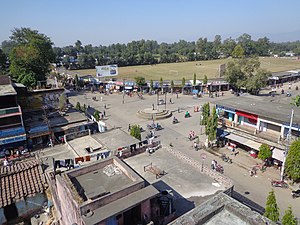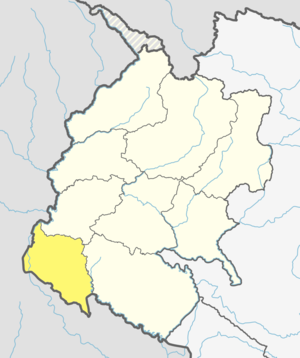Kanchanpur District
 From Wikipedia - Reading time: 9 min
From Wikipedia - Reading time: 9 min
Kanchanpur District
कञ्चनपुर जिल्ला | |
|---|---|
 Madan Chowk at Bhimdatta municipality | |
 Location of Kanchanpur District | |
 Divisions of Kanchanpur District | |
| Coordinates: 28°50′N 80°20′E / 28.833°N 80.333°E | |
| Country | |
| Province | Sudurpashchim Province |
| Established | 1860 |
| Administrative Headquarters | Bheemdatta |
| Municipality | |
| Government | |
| • Type | Coordination committee |
| • Body | DCC, Kanchanpur |
| • Head | Mr. Phairu Tamang |
| • Deputy-Head | Mrs. Sanu Kumari Budthapa |
| Area | |
• Total | 1,610 km2 (620 sq mi) |
| Population (2011) | |
• Total | 451,248 |
| • Density | 280/km2 (730/sq mi) |
| Time zone | UTC+05:45 (NPT) |
| Main Language(s) | Doteli (37.9%), Tharu (25.4%), Nepali (16.1%), Baitadeli (5.2%), others (15.4%) |
| Major highways | Mahendra Highway |
| Website | ddckanchanpur |
Kanchanpur District (Nepali: कञ्चनपुर जिल्ला [ˈkʌnt͡sʌnpur] ), a part of Sudurpashchim Province in the Terai plain, is one of seventy-seven districts of Nepal. The district, with Bhimdatta as its district headquarters, covers an area of 1,610 square kilometres (620 sq mi) and had a population of 134,868 in 2001 and 171,304 in 2011.[1][2] It is located in south-western of Nepal. It is bordered by Kailali district in the east, Dadeldhura district in the north and with India in the south and west.
Before the reunification of Nepal by Gorkha King Prithvi Narayan Shah, this district was part of the Doti Kingdom. Nepal lost it to the East India Company after the Anglo-Nepalese war (1814–1816). Then the Kingdom of Nepal and the East India Company followed by territorial concessions of Sugauli Treaty.[3] Later on after the treaty of 1860, Nepal recovered this land along with Kailali, Banke and Bardiya. Its first headquarters was Belauri Municipality, and the current headquarter, Mahendranagr, was declared in 2019 B.S.
The majority of the population is ethnic Tharu community, and minor groups are the peoples that have migrated from the northern hilly region. The district is renowned for Shuklaphanta National Park and the 1,456.97 metres (4,780 ft) long multi-span suspension bridge over Mahakali River.
Jhilmila Lake, Bedkot Lake, Bandatal, Shovatal, and Vishnu Temple, Ranital are the other tourist attractions.
Geography
[edit]The district expands from 28 degrees 38 minutes to 29 degrees 28 minutes Northern latitudes and 80 degrees 03 minutes to 80 degrees 33 minutes Eastern longitudes.[4] It is situated at the end of westmost part of province and country on the corner of the south-west. Geographically it is on the terai, but the northern part of the district has some higher altitudes of elevation. The highest elevation of the district is 1528m, and the lowest is 176m. The main rivers of the region are Mahakali, Jobuda, Chaudhary, Mohana, Syal, Banhara, Sanbora and Doda[5]
| Climate Zone[6] | Elevation Range | % of Area |
|---|---|---|
| Lower Tropical | below 300 m (1,000 ft) | 85.2% |
| Upper Tropical | 300 to 1,000 m (1,000 to 3,300 ft) | 13.0% |
| Subtropical | 1,000 to 2,000 m (3,300 to 6,600 ft) | 1.8% |
Demographics
[edit]| Census year | Pop. | ±% p.a. | ||
|---|---|---|---|---|
| 1981 | 168,971 | — | ||
| 1991 | 257,906 | +4.32% | ||
| 2001 | 377,899 | +3.89% | ||
| 2011 | 451,248 | +1.79% | ||
| 2021 | 517,645 | +1.38% | ||
| ||||
| Source: Citypopulation[7] | ||||
At the time of the 2011 Nepal census, Kanchanpur District had a population of 451,248.
As their first language, 39.8% spoke Doteli, 25.5% Tharu, 15.9% Nepali, 5.2% Baitadeli, 4.0% Bajhangi, 2.3% Achhami, 1.6% Magar, 1.5% Bajureli, 1.3% Tamang, 1.1% Darchuleli, 0.4% Hindi, 0.3% Maithili, 0.2% Dailekhi, 0.1% Gurung, 0.1% Newar and 0.2% other languages.[8]
Ethnicity/caste: 28.8% were Chhetri, 25.8% Tharu, 16.0% Hill Brahmin, 7.7% Kami, 5.6% Thakuri, 3.8% other Dalit, 2.8% Magar, 2.3% Damai/Dholi, 1.6% Sarki, 1.5% Sanyasi/Dasnami, 1.4% Tamang, 0.6% Lohar, 0.4% Gurung, 0.3% Badi, 0.2% Newar, 0.1% Dhanuk, 0.1% Hajam/Thakur, 0.1% Kathabaniyan, 0.1% Kumal, 0.1% Musalman, 0.1% other Terai and 0.1% others.[9]
Religion: 95.1% were Hindu, 2.7% Christian, 1.1% Buddhist, 0.8% Prakriti, 0.1% Baháʼí, 0.1% Muslim and 0.1% others.[10]
Literacy: 70.5% could read and write, 2.1% could only read and 27.4% could neither read nor write.[11]
Divisions
[edit]Kanchanpur district is divided into 7 municipalities and 2 rural municipalities:
- Municipalities
- Rural municipalities
Communication and media
[edit]Websites, Online News Portal, FM Stations and News Papers of Kanchanpur District
- MNR Yellow Pages. Local Search Engine[12]
- NB Media Network[13]
- Suklaphanta FM 99.4 MHz[14]
- Radio Mahakali FM 96.2 MHz[15]
- Radio Belauri 105 MHz[16]
- Belauri Post Weekly
- Dishanirdesh Kanchan Post Weekly
- Farwest Times
- Chure Times
- Mahendranagar Post
- Abhiyan Daily
- Paschim Nepal Daily
- Dainik Khabar Daily
- New Janakranti Daily
- Radio Nagarik FM 104.3 MHz[17]
- Radio Rastriya 89.8 MHz[18]
- Radio Barasinga 102.2 MHz
- Radio Paschim Nepal 91.0 MHz
- Radio Kanchanpur 90.2 MHz[19]
- Radio Pahichaan FM 105.3 MHz
- Radio Sudur Sanchar 100.4 MHz[20]
- Radio Jhalari FM 105.9 MHz[21]
- Prabhu FM 102.5 MHz
Lakes In Kanchanpur District
[edit]References
[edit]- ^ "National Population and Housing Census 2011(National Report)" (PDF). Central Bureau of Statistics. Government of Nepal. November 2012. Archived from the original (PDF) on 18 April 2013. Retrieved 28 July 2015.
- ^ "Districts of Nepal (Population, Area & Capital)". Statoids. 7 December 2012. Retrieved 7 December 2012.
- ^ "History of Nepal Army". Official website of Nepal Army. Archived from the original on 28 December 2017. Retrieved 18 May 2017.
- ^ "District Development Committee, Kanchanpur".
- ^ कंचनपुर जिल्लाकाे संक्षिप्त परिचय [Short introduction of Kanchanpur district]. www.ddckanchanpur.gov.np (in Nepali). Retrieved 22 August 2018.
- ^ The Map of Potential Vegetation of Nepal - a forestry/agroecological/biodiversity classification system (PDF), Forest & Landscape Development and Environment Series 2-2005 and CFC-TIS Document Series No.110., 2005, ISBN 87-7903-210-9, retrieved 22 November 2013
- ^ "NEPAL: Administrative Division". www.citypopulation.de.
- ^ NepalMap Language [1]
- ^ NepalMap Caste [2]
- ^ NepalMap Religion [3]
- ^ NepalMap Literacy [4]
- ^ "mnryp.com".
- ^ "nepalbodh.com".
- ^ "Suklaphanta FM 99.4 MHz".
- ^ "Radio Mahakali FM 96.2 MHz".
- ^ "Radio Belauri 105 MHz".
- ^ "Radio Nagarik FM 104.3 MHz".
- ^ "Radio Rastriya 89.8 MHz".
- ^ "Radio Kanchanpur 90.2 MHz".
- ^ "Radio Sudur Sanchar 100.4 MHz".
- ^ "Radio Jhalari FM 105.9 MHz".
 KSF
KSF
